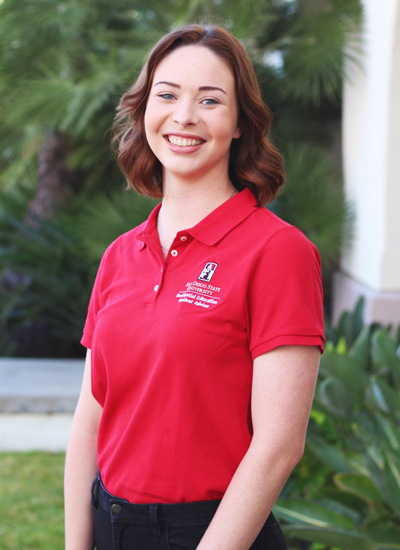California State University administrators, staff and faculty are laser-focused on
five key priorities to eliminate graduation rate equity gaps as part of
Graduation Initiative 2025:
- Reengage and reenroll underserved students
- Expand credit opportunities with summer/intersession
- Ensure equitable access to digital degree planners
- Eliminate administrative barriers to graduation
- Promote equitable learning practices and reduce DFW (D-F-Withdraw) rates
In the fourth installment of the five-part series on these GI2025 priorities, we'll see how the university has increased access to credit opportunities, especially during this past summer.
“Summer courses maximize the degrees of opportunity and freedom for students," says Salvador Hector Ochoa, Ph.D.,
San Diego State University provost and senior vice president. “These courses also provide students with a longer runway to finish, which is critical for degree completion. Especially for non-traditional learners, commuter students, students who work and those who are first-generation, taking summer courses allows them to feel like full-time students and to remain connected with their cohort."
A Longer Runway
As Dr. Ochoa explains, a primary benefit of offering summer and intersession courses is the flexibility it provides students, especially for those who work or need extra classes.
 “I would recommend summer courses, even as a first-year student, because that’s going to give you more space to be involved in clubs, to put more time to research or to connect with professors or graduate students.” —Amanda Roosma
“I would recommend summer courses, even as a first-year student, because that’s going to give you more space to be involved in clubs, to put more time to research or to connect with professors or graduate students.” —Amanda Roosma
“It gives opportunities for students to engage in other activities throughout the year to lessen their load, whether it be activities that they have to do because they are caregivers, have internships or even study abroad," says Sandra Temores-Valdez, SDSU senior director of Enrollment Services. “They can use summer as an extra semester to stay on track."
Taking advantage of that longer runway with summer classes has made it possible for SDSU senior Sarah Williams to ensure she can graduate in spring 2023 with a double major in business management and theater arts—and an honors minor in interdisciplinary studies.
“I have a lot of coursework to complete, and taking all those summer classes was necessary to keep me on a five-year track—let alone a four-year track—with two majors and a minor," Williams says. “Summer was not even a question for me. It is what I utilized to stay on track and reduce the burden of those two majors during the school year."
Without that opportunity, she estimates she would've taken 18 to 21 units a semester or increased her degree timeline to six years.
California State Polytechnic University, Humboldt senior Amanda Roosma is also depending on summer courses to reach her spring 2023 graduation date as she balances an intensive marine biology major, works on campus and rows for the university team. Summer session has been especially helpful as her college career was further extended by transferring between several schools before landing at Cal Poly Humboldt.
“I would either have to drop something and commit to 20 units this semester or I would have to see if there were courses offered next summer so I could avoid an extra full year or semester," Roosma says. “But that doesn't have to be the case anymore, and taking summer classes was a way for me to avoid that. This alleviates so much pressure from getting into that one class you need or satisfying that one requirement."
The Finance Question
However, securing funding for summer courses isn't always easy for students, leading CSU campuses to find ways to help meet students' financial needs. San Diego State, for example, has been running its summer session stateside—rather than as a self-support model—for about a decade, which means the university can use state funding to support the program and provide financial aid.
Beginning this summer,
California Polytechnic State University, San Luis Obispo not only switched its summer session to a stateside support model, but reduced the overall cost per unit. Using state, system and institutional funds, the university offered a grant to cover summer tuition for Pell- and/or Cal Grant- eligible students taking at least six units.
“That makes a difference when our lower-income students have to come up with the money themselves and are working over the summer to pay for the academic year," says Gerrie Hatten, executive director of Financial Aid at Cal Poly San Luis Obispo. “We know our lower-income students suffered at a greater rate than our more affluent students through the pandemic. … We're still reeling from that, and the fact that these students can then take summer courses at no cost can help get them back on track."
 "I would advise new students to look at summer classes at the university and not be frightened by the price, because there are financial aid and scholarships out there." —Odalys Martinez
"I would advise new students to look at summer classes at the university and not be frightened by the price, because there are financial aid and scholarships out there." —Odalys Martinez
These funding opportunities helped increase summer access for the targeted students at Cal Poly San Luis Obispo, as underrepresented students made up a greater percentage of those participating this summer than they do during the regular school year.
“As a Cal Poly scholar and also an EOP scholar, the funding they offered to pay for the classes was pretty helpful because that way I could just take care of housing," says Odalys Martinez, architectural engineering sophomore. “I didn't have to worry about paying a lot, and I could take on the class load."
The opportunity allowed Martinez to take two general education courses following her first year to get ahead on her classes without the worry of being waitlisted. This is especially important because she's taken on a demanding major and plans to study abroad one summer.
“It also mentally keeps me prepared, and I can keep in the practice of studying," she says.
Cal Poly Humboldt took a different approach: The university kept summer classes on their self-support model, but used system funding to offer free summer session classes to undergraduate students who took six units or fewer.
“If a student has made 24-units worth of progress in their first year and they take six units during the summer, they're entering their second year at 30 units rather than at 24 units," says Amber Blakeslee, Cal Poly Humboldt executive director of Finance and Budget. “So, the goal is that summer courses would be impactful on their progress."
Roosma says of having her summer tuition covered: “The classes I took were free, which was amazing. It makes you want to work harder because you are receiving such a great benefit and you want to take every opportunity you can."
ACCESS AND FLEXIBILITY
Even if tuition is paid for, taking summer courses can be an added financial drain if students have to pay for housing and other expenses. This is especially true for Cal Poly San Luis Obispo, where 90 percent of the student body comes from more than 100 miles away.
“In the past, most of our summer offerings were done in person, and students had to be in residence," says Joseph Borzellino, Ph.D., Cal Poly director of Enrollment Planning and Management. “That was certainly a burden for lower-income students to actually live in the area while they were taking summer classes."
To increase access and reduce the burden, the university encouraged departments to make summer classes available virtually when possible. As a result, the university saw summer participation numbers jump to their highest since the 1990s.
“That we can offer courses virtually and increase accessibility of the courses for summer is huge," says Beth Merritt Miller, Ph.D., Cal Poly assistant vice provost for University Advising. “It's encouraging that we are looking at how we can best serve our students post-pandemic, and this gives us an opportunity to analyze how to be more strategic in closing the equity gaps and helping with our graduation rates."
San Diego State likewise focused on offering a higher degree of virtual classes during the summer. For courses requiring an in-person lab, the university implemented hybrid courses featuring virtual lectures.
STRATEGIC SCHEDULING
To make summer and intersession a viable option for earning credits, CSU campuses also need to offer courses students need or want to take.
“With the pandemic, we did see higher DFW rates," Dr. Borzellino says. “Summer is going to be needed for students who fell behind. This is an opportunity for them to catch up."
For this reason, both Cal Poly San Luis Obispo and Cal Poly Humboldt focused their summer schedules on courses with high DFW rates. Cal Poly Humboldt particularly concentrated on courses taken in the first two years, increasing class offerings by 41 percent and student summer enrollment by 60 percent.
 "Taking summer school courses to lessen your load during the school year can help when juniors and seniors take on part-time jobs, internships and other things that come into play when we get into our upper division years." —Sarah Williams
"Taking summer school courses to lessen your load during the school year can help when juniors and seniors take on part-time jobs, internships and other things that come into play when we get into our upper division years." —Sarah Williams
“Being able to have a strong summer footprint is going to help students bridge their progress academically, increase their number of units and successfully advance toward graduation," says Carmen Bustos-Works, Ph.D., Cal Poly Humboldt associate vice president of Academic Programs.
SDSU has focused for several years on increasing the availability of high-demand courses in the summer, particularly early STEM classes, those that tend to have higher DFW rates and courses that are common prerequisites for large majors and have long waitlists. The university has also recently worked to offer a blend of lower- and upper-division courses. As a result, more than 10,000 students enrolled in the 2020 and 2021 summer sessions.
“In the beginning it was mostly lower division, 100- and 200-level classes," says William Tong, Ph.D., SDSU vice provost. “Now we're encouraging departments to offer 300- and 400-level courses, especially the high DFW classes, so that students can make up for it in the summer and stay on track."
The availability of those upper-division courses is what's allowed SDSU student Sarah Williams to continue relying on summer session to progress toward graduation. “I feel super grateful that there are so many upper-division classes available because it has allowed me to take classes every single summer," she says. “If there were only lower-division courses, I would've had to stop taking summer courses two summers ago, and I probably would've been in a stickier situation when it came to my graduation timeline."
In addition, SDSU also considers the sequencing of classes when planning out the summer schedule by considering which courses are common prerequisites and what order the courses are taken in. For example, not only would the university offer a high-demand class like chemistry 100 in the summer, but it would offer it during Session One, then offer chemistry 200 in Session Two, so students can complete both courses in a single summer.
“From a student's lens in terms of sequences, we have to think about different audiences who are going to be available to take classes at different times," says Stefan Hyman, Ph.D., SDSU associate vice president for Enrollment Management. “If we want to enroll more of our incoming students, then we have to be thinking about Session Two, after students have completed high school."
SUMMER LIFE
While summer session undoubtedly affords students more flexibility and helps them get ahead with their degree progress, the slow months of summer may challenge universities to provide that usual campus culture for those taking in-person classes.
To address this, SDSU worked to “create an atmosphere of a college campus," through programmed summer activities like baseball games, hikes and going to Disneyland, explains Randall Timm, Ph.D., associate vice president for Campus Life and dean of students. “Whatever we can do to create that college experience over the summer has been key. Few students want to walk on a half empty college campus in the summer, disconnected from campus life. So we’ve been intentional in setting up co-curricular options, social gatherings and service learning—now all year long."
 "Engaging with the students that I was on campus with was really helpful, because you build a community at Cal Poly and you see them throughout the school year." —Odalys Martinez
"Engaging with the students that I was on campus with was really helpful, because you build a community at Cal Poly and you see them throughout the school year." —Odalys Martinez
Oftentimes, the quiet of summer also means smaller in-person classes where students can better connect with their professors and peers. While living at Cal Poly San Luis Obispo during the summer, Martinez built her community as she planned study groups, met with her professors and worked at
EPIC-Engineering Possibilities in College, a university engineering camp for middle and high school students.
“It was helpful being on campus, working with professors on campus and getting to know them," Martinez says. “We talked about future classes, and then they also gave life advice. I was able to network more with engineering, find more career possibilities and learn more about potential internships in the future."